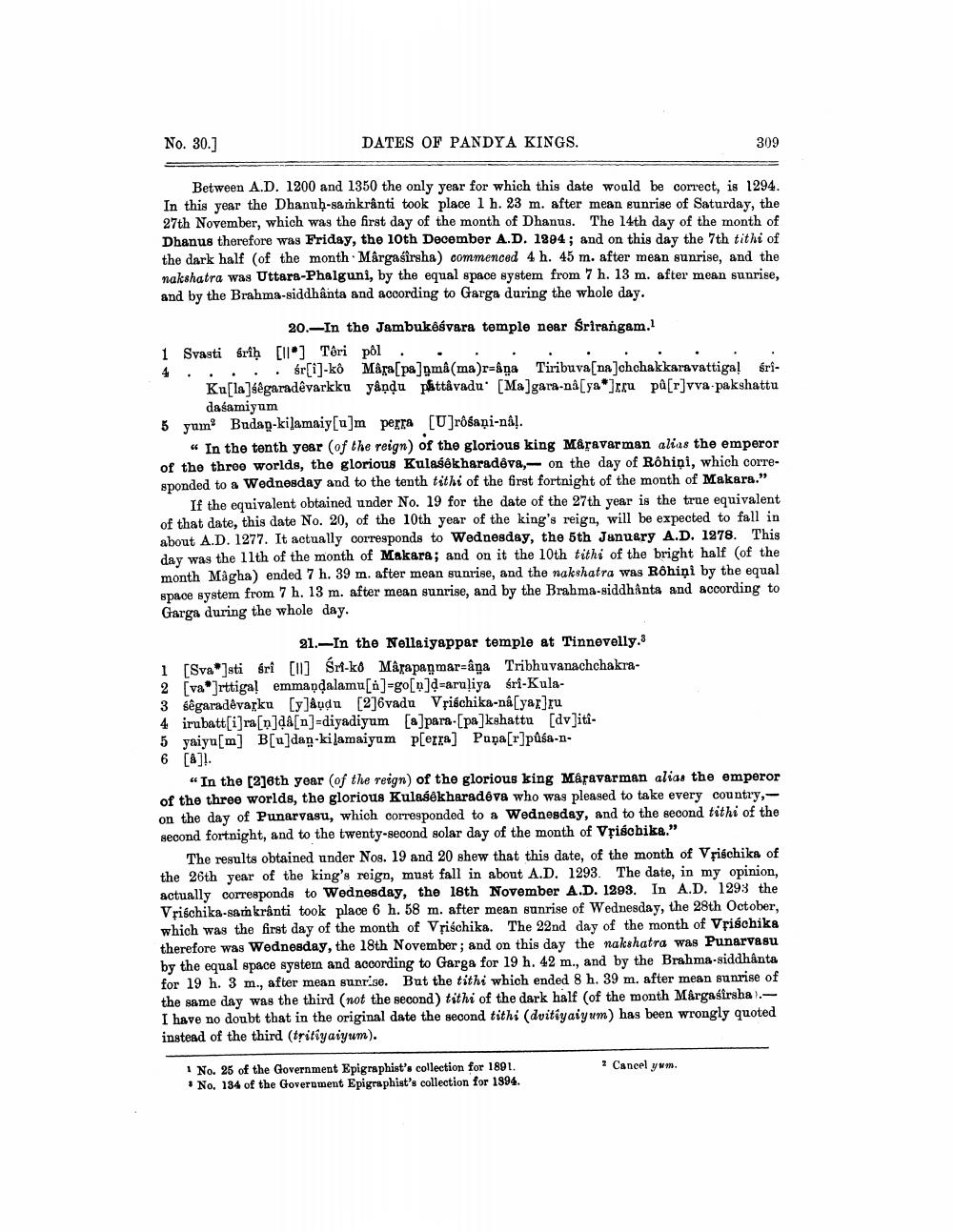________________
No. 30.]
DATES OF PANDYA KINGS.
309
Between A.D. 1200 and 1350 the only year for which this date would be correct, is 1294. In this year the Dhanuh-samkranti took place 1 h. 23 m. after mean sunrise of Saturday, the 27th November, which was the first day of the month of Dhanus. The 14th day of the month of Dhanus therefore was Friday, the 10th December A.D. 1994; and on this day the 7th tithi of the dark half of the month Margasirsha) commenced 4 h. 45 m. after mean sunrise, and the nakshatra was Uttara-Phalguni, by the equal space system from 7 h. 13 m. after mean sunrise, and by the Brahma-siddhanta and according to Garga during the whole day.
20.-In the Jambukåsvara temple near Srirangam. 1 Svasti friḥ [ll"] Téri pôl. 4 . . . . . śr[i]-kő Mára[pa]gma(ma)r=&ņa Tiribuva[na]chchakkaravattiga! sri
Ku[la]ségaradêvarkku yându påttåvadu [Ma]gara-nå[yarru p[r]vva pakshattu
dasamiyum 5 yum? Budap-kilamaiy[u]m perra [U]rôśani-nal.
“ In the tenth year of the reign) of the glorious king Måravarman alias the emperor of the three worlds, the glorious Kulasekharadêva, on the day of Rôhiņi, which corresponded to a Wednesday and to the tenth tithi of the first fortnight of the month of Makara."
If the equivalent obtained under No. 19 for the date of the 27th year is the true equivalent of that date, this date No. 20, of the 10th year of the king's reign, will be expected to fall in about A.D. 1277. It actually corresponds to Wednesday, the 5th January A.D. 1978. This day was the 11th of the month of Makara; and on it the 10th tithi of the bright half of the month Màgha) ended 7 h. 39 m. after mean sunrise, and the nakshatra was Rôhiņi by the equal space system from 7 h. 13 m. after mean sunrise, and by the Brahma-siddhanta and according to Garga during the whole day.
21.-In the Nellaiyappar temple at Tinnevelly. 1 (Sva]sti sri [ll] Śr-k8 Mârapaņmar-âņa Tribhuvanachchakra2 [va]rttiga! emmaņdalamu[6]-go[n]d-aruliya sri-Kula3 sêgaradêvarkı [y]audu [2]6vadu Vriechika-na yax]xu 4 irabatt[i]ra[n]de[n]-diyadiyum [a]para-[pa]kshattu [dv]iti5 yaiyu[m] B[u]dan-kilamaiyum p[erra) Pupa[r]puša-n6 [8]!.
"In the [2]6th year of the reign) of the glorious king Mâravarman alias the emperor of the three worlds, the glorious Kulasekharadeva who was pleased to take every country,on the day of Punarvasu, which corresponded to a Wednesday, and to the second tithi of the second fortnight, and to the twenty-second solar day of the month of Vsiścbika."
The results obtained under Nos. 19 and 20 shew that this date, of the month of Vrischika of the 26th year of the king's reign, must fall in about A.D. 1293. The date, in my opinion, actually corresponds to Wednesday, the 18th November A.D. 1293. In A.D. 1293 the Vrischika-sankranti took place 6 h. 58 m. after mean sunrise of Wednesday, the 28th October, which was the first day of the month of Vrischika. The 22nd day of the month of Vrischika therefore was Wednesday, the 18th November; and on this day the nakshatra was Punarvasu by the equal space systern and according to Garga for 19 h. 42 m., and by the Brahma-siddhanta for 19 h. 3 m., after mean sunrise. But the tithi which ended 8 h. 39 m. after mean sunrise of the same day was the third (not the second) tithi of the dark half of the month Margasirsha.I have no doubt that in the original date the second tithi (dvitiyaiyum) has been wrongly quoted instead of the third (tritiyaiyum).
? Cancel yum.
I No. 25 of the Government Epigraphist's collection for 1891. • No. 134 of the Government Epigraphist's collection for 1994.




